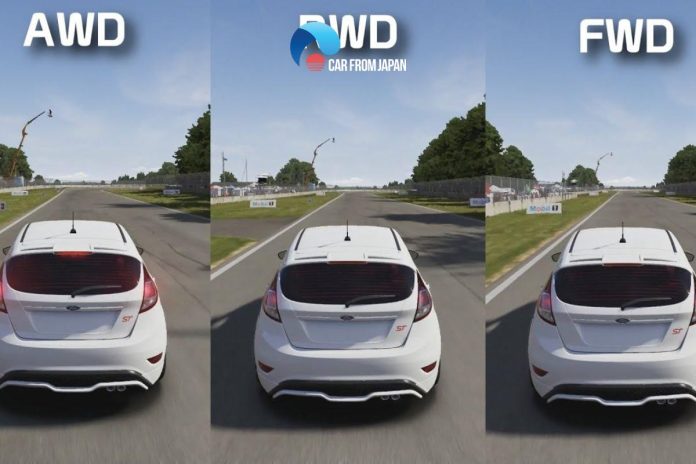Some car owners like the challenge of modifying their vehicles. The front-wheel driving controls the steering and pushes the weight to the back of the car on acceleration. Every high-power car manufacturer follows the rear-wheel drive setup.
You can convert front-engine cars into a mid-mounted engine for rear-wheel drive, which lends power to the back wheels.
However, many car owners are still not aware of the process involved in the FWD to RWD conversion.
Contents
- Overview Of FWD And RWD Systems
- What Is The FWD To RWD Conversion?
- How To Convert FWD To RWD?
- FAQs on FWD to RWD Conversion
- Can I reuse the original FWD transmission in a RWD conversion?
- Why do some enthusiasts prefer converting FWD to RWD instead of buying a RWD car?
- Is it legal to convert a FWD car to RWD for street use?
- What cars are best suited for a FWD to RWD conversion?
- Are there any “bolt-on” kits for FWD to RWD conversions?
- What’s the average cost of a FWD to RWD conversion?
- Summary
Overview Of FWD And RWD Systems
Before finding detailed steps to convert FWD to RWD, we will take a brief look at these two drive systems.
Front-wheel drive (FWD)
FWD is a front-wheel drive system, meaning that the two front wheels will directly receive the “force” transmitted from the engine. The two front wheels will actively rotate and “pull” the two rear wheels to roll along.
Currently, most vehicles have the engine and transmission located in the front, so using the front-wheel drive is the simplest option.
One of the advantages of this system is that the power from the engine will be transmitted to the front wheel as quickly as possible, ensuring that not much energy is consumed during the transmission (due to the engine and drive system being placed close together).
However, the FWD system also has a disadvantage in that most of the weight of the front-wheel drive will be concentrated in the front end, resulting in poorer acceleration compared to other types of drive systems.
Rear-wheel drive (RWD)
The operation of this system is similar to FWD but in this system, the 2 rear wheels rotate and “push” the 2 front wheels to roll along.
For vehicles with a front-mounted engine, the power from the engine will be transmitted to the drive shaft located on the rear axle via a crankshaft.
As for sports cars or supercars with mid-engined cars (behind the driver’s seat) or rear, there is no need for a crankshaft.
Thanks to the balanced weight distribution between the front and rear axles, RWD cars have a better grip on the road than the front wheels.
Acceleration capability is also better. It can be said that the rear-wheel drive system helps to overcome the disadvantages of front-wheel drive vehicles.
However, due to the need to go through the axles, RWD is sometimes a waste of power and transmission energy.
Watch the video from BodeVision to have a better understanding about Front Wheel Drive and Rear wheel drive!
What Is The FWD To RWD Conversion?
A rear-wheel drive conversion is not a new concept, as car drivers have been experimenting to achieve the perfect RWD conversion for years.
A standard rear-wheel drive procedure includes cutting the car, designing a new chassis, and reassembling the entire thing with an engine, and a drive train.
How To Convert FWD To RWD?
Many want to know how to convert FWD to RWD questions. There is a simple method for you to turn an FWD car into an RWD one.
Purchase an automatic transmission front-wheel drive car
If you have decided to go for the conversion, then it would be worthwhile to get an engine, which provides the necessary power.
For example, if you are looking to convert a four-cylinder, then you should choose a V6 model from the same engine manufacturer.
It is the first step to help you in successful FWD to RWD Conversion without any hassle.

Read More: FWD or RWD – Which One to Choose
Remove everything from the front side
Now that you have a car, it is time to remove the front clip from the vehicle. It includes removing the car engine, transmission, suspension, front-cross member, and strut tower.
However, keep in mind not to damage the computer or any other wires.
Creating the sub-frame
You would need to generate a sub-frame for the drive assembly. You can weld tubular supports along the corners of the strut towers and connect them with the frame.
Next, you need to connect the strut towers with a removable brace, which bolts the tower’s strut mounts. It is an essential step during the Rear-wheel drive conversion process.

Installing the bar
You need to install a toe-adjustment bar with independent rear suspension, which works in rear-drive cars. Besides, install it in place of the stock power steering back.
We recommend that you locate the toe-bar, threaded to the stock steering end links. If you want to perform a successful front-wheel drive to rear-drive conversion, do not forget this step.
Cutting the rear part of the car
You would need to cut the rear part of the car to fit the assembly in the car trunk, and rear seat area. For this to work, you would need to connect the welded subframe with the car’s body.
We recommend that you utilize quarter-inch plate steel or rectangular tubing to get the job done.
It would be wise to enlist the help of a car conversion professional who would have the right rear wheel drive conversion kits to do the work.

Fabricating lightweight frame
Now, you should build a lightweight frame from square stock tubing around the engine.
Besides, cover the framework with half-inch pressure-treated plywood, and connect the plywood to the frame with piano hinges for easy access to the car engine.
The plywood is an excellent option, as it is an insulator against heat and noise penetration. If you want to know how to make a FWD car RWD, then this is an essential step.
Reconnect everything
Lastly, reconnect the new engine to the previous car’s computer, fuel tank, AC lines, condenser, radiator, battery, and other gauges.
You can connect the car’s gear shifter to the new transmission using a universal shifter cable, or extend the wires connecting the shifter to the transmission.

FAQs on FWD to RWD Conversion
Can I reuse the original FWD transmission in a RWD conversion?
Not typically. FWD transmissions are mounted transversely and do not support a driveshaft connection.
You’ll usually need to swap in a longitudinal RWD-compatible transmission.
Why do some enthusiasts prefer converting FWD to RWD instead of buying a RWD car?
Some do it for the challenge, to keep a sleeper build, or to repurpose a lightweight FWD platform they already own.
It’s more about custom performance or sentimental value than practicality.
Is it legal to convert a FWD car to RWD for street use?
Legality depends on your country or state. In many places, such modifications must pass inspection for safety, emissions, and registration compliance.
Some jurisdictions may require engineering certification.
What cars are best suited for a FWD to RWD conversion?
Older Hondas (like the Civic or Accord), compact Mazdas, or small coupes with ample engine bay room and aftermarket support tend to be common. But even then, it’s far from straightforward.
Are there any “bolt-on” kits for FWD to RWD conversions?
No true bolt-on kits exist due to the extensive chassis and drivetrain differences.
Some tuners offer partial kits or templates, but expect heavy customization regardless.
What’s the average cost of a FWD to RWD conversion?
Costs can range from $5,000 to over $20,000, depending on how much fabrication, parts sourcing, and custom tuning is needed.
Labor alone is a major factor if you’re not doing it yourself.
Summary
If you were looking to learn about doing FWD to RWD Conversion, then we hope this guidelines will help you accomplish the mission without any hassle.
For more insightful Car maintenance tips, follow Car From Japan today!




how expensive do you think this is? and Is it worth it in you r opinion?
Depends on the type of car you have. If you’ve got a budget and lots of time, I’d say go for it, but in terms of expenses, you’re likely much better off to just buy an FR and save yourself the time and trouble…